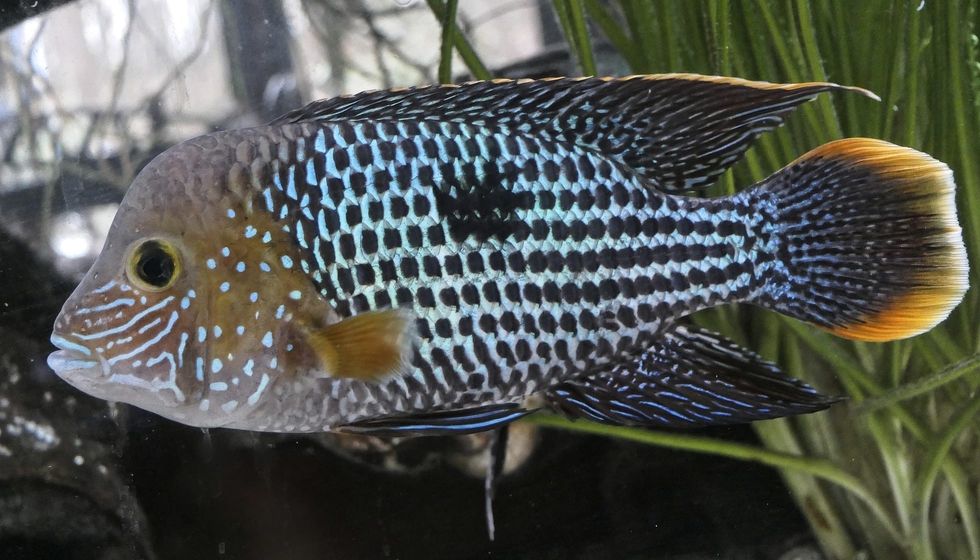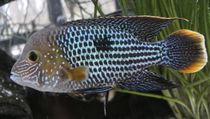The Egyptian mouthbrooder (Pseudocrenilabrus multicolor) is a native fish of northeast Africa spread to Tanzania. They were imported to Europe in 1902 and named dwarf Victoria mouthbrooders.
It belongs to the genus Pseudocrenilabrus, Pseudo means fake, and crenilabrus means cut lip. The species name multicolor meaning- many-colored. This kind of cichlid is pretty common.
However, recently they have been decreasing in population. These tropical fishes prefer freshwater habitats such as lakes and rivers under specific water temperature between 68-75 degrees F (20-23.9 degrees C), with pH levels 6.5 - 7.5 (Medium soft water to relatively hard water). Egyptian mouthbrooders are pretty aggressive during the breeding season.
It is the best choice to keep a single male with a harem of many female dwarf cichlids. This bottom-dweller is entirely territorial towards catfish, loaches, and other dwarf cichlids.
These dwarf fishes are abundant in nature and can be easily cultivated. However, recent years have been challenging due to the increased number of predator conservation steps as preventive measures.
If you are an aquatic fish lover and fascinated by aquarium and tank fishes, you might want to sign in and check out our article about exciting facts on pumpkinseed sunfish and oscar fish.
Egyptian Mouthbrooder Interesting Facts
What type of animal is an Egyptian mouthbrooder?
The dwarf Victoria mouthbrooder is small cichlid fish that grows to 3.1 in (8 cm) only but is hyper-aggressive. They are highly territorial and refuse to share their space with other bottom dwellers.
And due to its aggressiveness, too many males in the same space can be tricky. However, it is safe to have one male and many females in an aquarium.
What class of animal does an Egyptian mouthbrooder belong to?
The Egyptian mouthbrooder (Pseudocrenilabrus multicolor) fish belongs to the ray-finned class Actinopterygii.
How many Egyptian mouthbrooders are there in the world?
Their exact population size is not recorded. However, these beautiful tropical fish are more into the pet trade.
Where does an Egyptian mouthbrooder live?
These Egyptian mouthbrooders are found in freshwater like rivers, lakes, pond pools, and creeks, where they have sandy gravel bottoms with algae and other tiny planktonic beings.
What is an Egyptian mouthbrooder's habitat?
Egyptian mouthbrooders are tropical freshwater fish, requiring warm temperature and non-saline waters to survive. The waters should be moderate soft to relatively hard; however, these fishes are hardy and can adapt to slightly increased alkaline waters also. Being bottom-dwellers, they need sandy gravel bottoms and a rich algae habitat. Similar conditions are required in aquariums for petting these species.
Who do Egyptian mouthbrooders live with?
Egyptian mouthbrooders are aggressive and have territorial feelings, and in house tanks and aquariums, they may fight with other bottom dwellers such as catfish, loaches, and other dwarf species. However, they are relatively peaceful with upper to medium level fishes like hatchet fish, rainbowfish, or deep-bodied tetras.
How long does an Egyptian mouthbrooder live?
Egyptian mouthbrooders have a life expectancy span of four years.
How do they reproduce?
The breeding and brooding are the festinating aspects of these African species. The male draws females by digging the depression on the sandy bottom using its fanny tail as a sign to begin spawning.
Males are aggressive in perusal attempts once the female is lured into the nest, the male and female dances in circular motions. It is believed that this dance triggers the release of eggs in females.
Mothers collect the eggs in their mouths and pursue males to fertilize eggs for spawning. This courtship sequence is repeated four to five times till the female collects 100 eggs in its mouth. And following 9-11 days, the females do not feed and wait for the incubation period to end.
Two weeks later, small fries appear in the mother's mouth. Throughout breeding, fries hover in and out of the mother's mouth for another three weeks and then are released.
The young fry feeds on a planktonic diet at a very young age. It takes over a year for them to attain sexual maturity.
What is their conservation status?
They are listed as of Least Concern as per the IUCN. Recent years have been challenging because of water pollution, increased competition, and predation, all of which are affecting this species. In addition, overfishing and selling in the pet trade is also a concerning cause that is affecting its number.
Egyptian Mouthbrooder Fun Facts
What do Egyptian mouthbrooders look like?

*Please note the main image and this image are of a Andinoacara rivulatus that belongs to the same family as the Egyptian mouthbrooder. If you have an image of a Egyptian mouthbrooder please let us know at hello@kidadl.com.
Dwarf Victoria mouthbrooders have an elongated oval body with colorful shade scales. They have a metallic blue-green sheen and orange color pattern on the fins. The caudal fin has a V shape that helps create depressions on sandy gravel to attract the female to breed. The male anal fin has red spots on the end.
Males are larger and more colorful, whereas females are noticeably smaller and paler with a gray complexion. Attractive color patterns on males are helping them to breed.
How cute are they?
We think they are pretty cute. Due to their attractive color pattern, these fish are kept in tanks and aquariums.
How do they communicate?
The Egyptian mouthbrooder communicates just like any other species of cichlids by sounds and body movements. There is no other specific mode of communication; however, these fishes are super aggressive.
How big is an Egyptian mouthbrooder?
Pseudocrenilabrus multicolor fish grows 3.1 in (8 cm) which is thrice the size bigger than Indonesian superdwarf fish, which only grow up to 0.41 in (1.04 cm).
How fast can an Egyptian mouthbrooder swim?
These African mouthbrooders are not like pelagic swimmers, and they are confined to small lakes or pools. Hence their movement is restricted and does not emphasize speed. However, during spawning, they move in a rapid circular motion. The exact speed of this community species is unknown.
How much does an Egyptian mouthbrooder weigh?
The exact weight of these species is not documented, but they are assumed to be lightweight and easy to keep as a pet.
What are the male and female names of the species?
The mouthbrooder's community is quite simple. They do not have sex-specific names.
What would you call a baby Egyptian mouthbrooder?
Commonly young Egyptian mouthbrooders are known as fry.
What do they eat?
Most multicolor species are not fussy about food. Instead, they are omnivores that feed on algae and tiny planktonic animals.
In aquariums, their diet consists of flake food, micropellets food, small frozen foods such as bloodworm, white mosquito larvae, enriched brine shrimp, and daphnia. They prefer feeding on live food.
Are they dangerous?
Pseudocrenilabrus multicolor are small fishes but highly aggressive during feeding and breeding. They have a solid territorial claim and may fight with other bottom dweller fishes such as catfish, loaches, and other cichlid aquatic animals.
Would they make a good pet?
Egyptian mouthbrooders are mostly common petting animals due to their small size and lightweight. However, it needs a lot of requirements for keeping it in-house tank and aquariums.
A group can be kept in a 20-gallon (90.9 lt) tank. The aquarium needs to be decorated with dense water plants small sized caves, at least a cave per fish. Territorial borders should be assigned to reduce aggressiveness.
Its always best to maintain the ratio of fishes like one male with a couple of females and avoid keeping timid fishes in the same tank. The aquarium needs sound filtration and good water quality with pH 6.7-7.5 and temperature 68 -75 degrees F (20-23.9 degrees C).
Did you know...
Most cichlids are mouthbrooders. They actively defend territories while courting females and while feeding.
They breed freely in water under optimal conditions. After spawning, the female keeps the eggs in her mouth for few weeks, and even after eggs hatch in her mouth, the babies still reside in the mother's mouth until they are old enough to take care of themselves.
Don't you think these mouthbrooder females deserve a mother of the century award?
After birthing, the mother Egyptian mouthbrooder is very aggressive; in some cases, it even attacks and kills the male. The male only exhibits aggressive behavior during spawning.
How does the cichlid fish keep its offspring safe?
The mother Pseudocrenilabrus multicolor breed has a strong maternal instinct. They brood their eggs in their mouth to protect from being eaten by other fishes.
The incubation period lasts for two weeks. Even after hatching, the young ones reside in their mothers' mouths until they are big enough. When predators pass their territory, the babies hide in their mother's mouths throughout the breeding season.
Can you keep Egyptian mouthbrooders with other fishes?
Egyptian mouthbrooders are highly competitive within their species itself. Males have pursual instincts during spawning. It's best to keep one male with few females in the tank.
Other bottom dwellers such as catfish, loaches, and other dwarf species are not feasible options to keep in the same tank. These Egyptian mouthbrooders only submit to companions that are large enough to swallow them. Therefore, keeping fish of the same size is not advisable.
Here at Kidadl, we have carefully created lots of interesting family-friendly animal facts for everyone to discover! Learn more about some other fishes from our black marlin facts and stingray facts pages.
You can even occupy yourself at home by coloring in one of our free printable egyptian mouthbrooder coloring pages.









